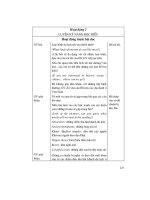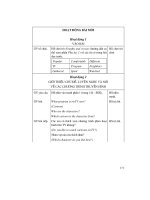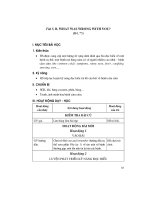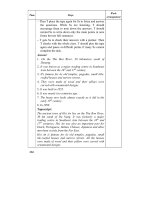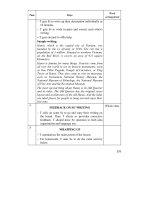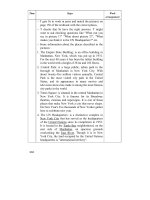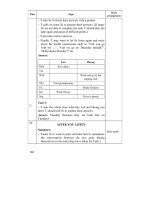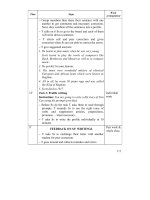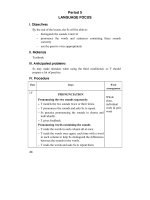Thiết kế bài giảng tiếng anh 10 tập 1 part 1 docx
Bạn đang xem bản rút gọn của tài liệu. Xem và tải ngay bản đầy đủ của tài liệu tại đây (399.93 KB, 23 trang )
1
nguyÔn thuû minh - l−¬ng quúnh trang
ThiÕt kÕ bμi gi¶ng
TËp mét
Nhμ xuÊt b¶n Hμ néi
2
Lời nói đầu
Để hỗ trợ cho việc dạy, học môn Tiếng Anh 10 theo chơng trình sách
giáo khoa mới ban hành năm học 2006
2007, chúng tôi biên soạn cuốn
Thiết kế bài giảng Tiếng Anh 10 gồm hai tập. Sách giới thiệu một cách thiết
kế bài giảng Tiếng Anh 10 theo tinh thần đổi mới phơng pháp dạy học nhằm
phát huy tính tích cực nhận thức của học sinh.
Về nội dung: Sách đợc viết theo đúng trình tự các bài học trong sách
giáo khoa lớp 10: gồm 16 bài, mỗi bài đợc chia thành từ 5 đến 6 tiết. ở mỗi
tiết học đều chỉ rõ mục tiêu, đồng thời chỉ rõ các công việc chuẩn bị của giáo
viên, các phơng tiện trợ giảng cần thiết nhằm đảm bảo chất lợng từng tiết
học trên lớp.
Trình tự các bớc tiến hành bài giảng đợc chia thành các hoạt động:
Kiểm tra bài cũ, Hoạt động bài mới, Củng cố kiến thức, Bài tập về nhà và
Hoạt động bổ trợ. Hoạt động bài mới đợc thiết kế thành những hoạt động
1, 2 theo các phần nhỏ đúng trình tự trong sách giáo khoa. ở mỗi hoạt
động nhỏ này đều đợc thiết kế theo mô hình Pre- While Post cho từng kĩ
năng. Hoạt động bổ trợ bao gồm các trò chơi, bài tập bám sát nội dung của
tiết học. Giáo viên có thể lựa chọn và lồng ghép vào các hoạt động khác trong
tiết học hoặc tiến hành sau khi đã hoàn thành các hoạt động chính trong bài.
Về phơng pháp: Sách đã cố gắng vận dụng phơng pháp dạy học mới
để chuyển tải từng nội dung cụ thể của bài học. ở mỗi tiết học tác giả đa ra
một loạt các hoạt động lồng ghép nh: xem tranh, đoán tranh, làm việc theo
cặp, theo nhóm, nhằm phát huy tính tích cực, tự giác trong học tập của học
sinh. Đặc biệt, nhằm hình thành đồng thời cả 4 kĩ năng: nghe (listening), nói
(speaking), đọc (reading), viết (writing) tiếng Anh, sách đã tập trung nhiều
vào hoạt động luyện tập trong mỗi giờ học. Ngoài ra, sách đa ra các tình
huống giao tiếp và trò chơi thích hợp, nhằm giúp học sinh có điều kiện củng
cố vững chắc bài học.
Chúng tôi hi vọng cuốn sách sẽ là tài liệu tham khảo hữu ích cho các
thầy, cô giáo dạy môn Tiếng Anh 10 trong việc nâng cao hiệu quả bài giảng
của mình. Đồng thời rất mong nhận đợc ý kiến đóng góp của các thầy, cô
giáo và các bạn đọc gần xa để cuốn sách ngày càng hoàn thiện.
Tác giả
3
Unit 1
A day in the life of…
Period 1
(Reading)
I. Aim
Reading for specific information about a day in the life of a farmer
II. Objectives
By the end of the lesson, Ss will be able to talk about their daily routines
by learning a typical day of a farmer.
III. Materials
Textbook, pictures about farmers and field work…
IV. Anticipated problems
Ss may not know what a farmer has to do during his/her working day.
V. Procedure
Time Steps
Work
arrangement
7’
Warm-up
Chatting
Ask Ss to work in pairs. Tell them to ask and answer
about their daily routines by using the cues:
E.g: What time you often get up
A: What time do you often get up?
B: I often get up at six.
Pair work
4
•
What time you go to school / have breakfast /
lunch / dinner / go to bed
• What you often do in the morning / afternoon/
evening
10’
Before you read
Vocabulary pre-teach
plough (v): furrow, turn up the soil (cày)
harrow (v): break the soil (bừa)
plot of land (translation): một miếng đất, mảnh ruộng
fellow peasants (n): farmers working in the same
field (đồng nghiệp, cùng là nông dân)
local tobacco (translation): thuốc lá được sản xuất tại
địa phương
take a short rest (v): have a rest for a short time
(nghỉ giải lao ngắn)
transplant (v): grow rice (cấy)
crop (n) (translation): vụ mùa
Checking technique
Sentence modelling
Ask Ss to make sentences with the above words to
make sure they understand their meanings
Whole class
5’
While you read
Set the scene
You are going to read two passages about a day in
the life of two farmers.
Task 1 - Multiple choice
Ask Ss to read the passages individually and choose
the option A, B or C that best suits the meaning of
the italicised word(s).
Individual
work
5
5’
5’
Advise Ss to read the passages quickly and stop at
the lines that contain the words to guess the closest
meaning.
Go around the class and provide help if necessary.
Call on some Ss to read aloud their answers. Ask
them to explain their choice.
Give correct answers:
1. C 2. C 3. A 4. A
Note: T may wish to further explain the words in
Vietnamese if necessary.
Task 2 - Answering questions
Have Ss work in pairs and ask and answer about the
passages.
Call on some pairs to do the task in front of the class.
Give feedback and suggested answers:
1. He’s a peasant/farmer.
2. He gets up at 4:30 and then goes down the
kitchen to boil some water for his morning tea.
3. In the morning, he ploughs and harrows his plot
of land, drinks tea and smokes tobacco during his
break.
4. In the afternoon, they repair the banks of their
plot of land. Mr. Vy pumps water into it and his
wife does the transplanting.
5. Yes, they are. Because they love working and they
love their children.
Task 3 - Note Completion
Ask Ss to scan the passage and make a brief note
about Mr. Vy and Mrs. Tuyet’s daily routines.
Tell Ss to compare their notes with a friend.
Give correct answers:
Pair work
Pair work
6
In the
morning
4:30:
The alarm goes off and Mr. Vy gets
up, goes down the kitchen, boils
water for tea, drinks tea, has quick
breakfast, leads buffalo to field.
5:15:
leaves house
5:30:
arrives in the field, ploughs and
harrows
7:45:
takes a break
10:30:
goes home
11:30:
has lunch with family
In the
afternoon
2:30p.m: Mr. Vy and Mrs. Tuyet go to the
field again, repair the banks of the
plot of land. He pumps water into
the plot of land. She does
transplanting.
6:00 p.m: finish work
7:00 p.m: have dinner
After
dinner
Watch TV, go to bed
sometimes visit neighbours, chat with them
10’
After you read
Ask Ss to work in groups and talk about Mr. Vy and
Mrs. Tuyet's daily routines.
Call on some Ss to give a short talk about the daily
routines of these two farmers. Correct Ss’
pronunciation mistakes.
Note:
1. This activity can be carried out through the game
True or False Repetition Drill.
T reads aloud 5 to 7 statements about Mr. Vy and
Mrs. Tuyet. If they are true, Ss will repeat them. If
they are false, Ss will stay silent. Ss who don’t
follow this rule will get a kind “punishment”
agreed by class.
Group work
7
2. T also lets Ss do the extra exercise in groups if
they wish.
3’
Wrapping
Summarise the main points.
Assign homework.
Whole class
Supplements
Exercise
Read the passage and answer the questions.
David is a bank manager and Rosa is a doctor in a large hospital. David
gets (1)…… at 7:30 am and (2)………a shower. He leaves home at 8:30
and goes to work (3)…… train. He arrives at the bank at 9:00.
Rosa gets up at 9:30 because she doesn’t start work until 1:00 in the
afternoon. She (4)………the bus to the hospital at 12:15.
David finishes work at 5:30 pm and (5)…… shopping in a supermarket
near the bank. Then he goes home and (6)……… the dinner. He eats alone
in the kitchen at 7:00 and then usually (7)……….TV in the living room
until Rosa arrives (8)…….home at 10:00. She often has her dinner in front
of the TV.
David goes to bed at 11:00, but Rosa usually goes to bed a bit later.
1. a. on b. up c. in d. about
2. a. has b. have c. does d. makes
3. a. in b. to c. up d. by
4. a. catches b. brings c. gets d. does
5. a. comes b. goes c. does d. buys
6. a. has b. eats c. cooks d. does
7. a. sees b. looks c. hears d. watches
8. a. in b. on c. _ d. at
Answers:
1. b 2. a 3. d 4. a
5. b 6. c 7. d 8. c
8
Period 2
(Speaking)
I. Aim
Speaking about one’s daily routine
II. Objectives
By the end of the lesson, Ss will be able to talk about his or her daily
routine by using given information and pictures.
III. Materials
Textbook, small cards of class timetable,…
IV. Anticipated problems
Ss may have difficulty in arranging daily activities in a good order for
describing.
V. Procedure
Time Steps
Work
arrangement
10’
Warm-up
Networks
Revision of school subjects
Ask Ss to work in groups of 3 to 4 and make a list of
the subjects they learn at school.
The groups with the most words within a limited time
will be the winner.
Note that all the words with wrong spellings are not
counted as the correct ones.
Subjects
Group work
9
Feedback and further explain all the subjects
mentioned above especially the ones Ss are not
familiar with.
10’
Presentation
Set the scene
Quan is a tenth-grade student. He goes to school
every morning. Now, look at his weekly timetable on
page 15. Ask and answer questions with a partner,
using the information from the timetable.
Examples:
A: What time does Quan have Civic Education lesson
on Monday?
B: He has Civic Education lesson at 7: 15 a.m.
A: What lesson does Quan have at 7: 15 a.m on
Monday?
B: (At 7:15 on Monday he has) Civic Education
lesson.
Let Ss work in pairs for about 7 to 10 minutes about
Quan’s routine.
Pair work
15’
Practice
Keep Ss work in pairs and ask them to study the
pictures carefully. If Ss find it difficult to understand
the pictures, T may help by asking questions such as:
What is Quan doing in picture a)? Is he getting up?
Ask Ss to describe Quan’s activities during the day.
Go to different pairs and offer help if necessary.
Feedback and give suggested answer.
Everyday Quan gets up at 14:00. Then he studies for
about two hours. He watches TV at 16:30. At 17:00
he rides to the stadium to play football with other
boys in the neighborhood. He gets back home at 18:30.
After having a shower, he has dinner with his family
Pair work
10
at 19:00. He prepares for the following day’s lesson
at 20:00.
7’
Further practice
Ask Ss to work in groups of 3 to 4 and talk about their
daily routine.
Note: Ss only talk about their main / important
activities.
Call on some Ss to present in front of the class.
Have other Ss comment on presenters’ performance
regarding content and pronunciation.
Group work
3’
Wrapping
Summarise the main points.
Assign homework.
Whole class
Supplements
Exercise
Match the word in A with the one in B.
A B
1. Civic a) Technology
2. School b) Meeting
3. Information c) Education
4. Class d) Report
Answers:
1. c 2. d 3. a 4.b
11
Period 3
(Listening)
I. Aim
Listening for specific information
II. Objectives
By the end of the lesson, Ss will be able to:
- talk about a day in the life a cyclo driver.
- improve listening skill by doing Pictures Ordering and True or
False exercises.
III. Materials
Textbook, cassette.
IV. Anticipated problems
Ss may not be familiar with the life of a cyclo driver.
V. Procedure
Time Steps
Work
arrangement
7’
Warm –up
Categorising
Ask Ss to work in groups and put the sentences into
the correct column.
He gets up very early.
He works in the streets.
He works with children.
He lives in the country.
He gets people from one place to another.
He corrects homework.
He works in school.
He meets a lot of people.
He works on the farm.
Group work
12
He is a farmer He is a teacher
He is a cyclo
driver
Feedback and give correct answers:
He is a farmer He is a teacher
He is a cyclo
driver
He gets up very
early.
He lives in the
country.
He works on the
farm.
He works with
children.
He corrects
homework.
He works in
school.
He works in the
streets.
He gets people
from one place to
another.
He meets a lot of
people.
10’
Before you listen
Ask and answer
Tell Ss to work in pairs to ask and answer the
following questions:
Have you ever travelled by cyclo?
When was it?
Is it interesting to travel by cyclo?
Which do you prefer, going by bicycle or by cyclo?
Give reason(s)?
Vocabulary pre-teach
district (n): an administrative division, smaller than
a province (quận, huyện)
drop (v): leave somebody at a place (chở ai đó đến
nơi…)
Pair work
and Whole
class
13
passengers (n): people who travel on a train,
bus…(hành khách)
pedal (n): a lever operated by foot to control a
bicyle or motorbike (bàn đạp)
purchases (n): things a person buys (đồ đạc mua)
food stall (n): small booth, compartment or kiosk
in/near a market where food is sold (quầy bán thực
phẩm)
Checking technique
Guessing
Write all the new words on the board.
Explain each word separately and ask Ss to guess
what the word is.
Set the scene
Mr. Lam is a cyclo driver. He is working in Ho Chi
Minh City. Let’s guess his routine. What does he do
in his job?
Encourage Ss to feel free to have gueses about Mr.
Lam’s routine.
10’
10’
While you listen
Task 1 - Pictures Ordering
Play the tape several times if necessary.
Ask Ss to listen to Mr. Lam’s talk about his daily
routine and number the pictures in their correct order.
Have Ss compare their answers with a friend.
Feedback and give correct answers:
a.3 b. 5 c.4 d. 6 e.1 f. 2
Task 2 - True or False
Let Ss read the statements carefully.
Play the tape again and ask Ss to listen and decide
whether the statements are true or false.
Individual
work and
Whole class
Individual
work and
whole class
14
Draw Ss’ attention to key words when they are
listening.
Call on some Ss to explain their answers.
Give correct answers:
1. F ( Not Given.)
2. T
3. F (He takes his passengers from District 5 to
District 1.)
4. F (His first passenger is an old man.)
5. F (He has lunch at a food stall near Ben Thanh
Market.)
6. F (He takes a short rest.)
Tapescript
Hello everyone, my name is Lam. I’m a cyclo driver
in Ho Chi Minh City. I usually have a busy working
day. I get up at five thirty in the morning. I start
work at six. My first passenger is usually an old
man. I take him from District 5 to District 1. After I
drop him at a café near Ho Chi Minh Teachers’
Training College. I pedal to Thai Binh Market. My
next passenger is a lady who does shopping there
every two days. I help her put all her purchases into
the cyclo and then take her to her shop in Tran
Hung Dao Street. At about ten thirty I ride off
toward Nguyen Thi Minh Khai School. There I park
my cyclo, chat with some of my fellows and wait for
my third passengers. They are two school pupils, a
girl and a boy. I take them home. At twelve I have
lunch at a food stall near Ben Thanh Market. After
lunch, I park my cyclo under a tree, take a short rest
and then continue my afternoon’s work.
15
5’
After you listen
Tell Ss to work in pairs and ask and answer
questions about Mr. Lam’s activities by using the
cues below:
name……………start………………work……………
lunch……………occupation……………passengers
…………rest
Go around the class and offer help if necessary.
Call on some pairs ask and answer in front of class.
Feedback and give suggested answers:
What is the man’s name?
What does he do?
What time does he start work?
Who are his passengers? / Is his first passenger an
old man?
Where does he have lunch? What time does he have
lunch?
Does he take a rest?
If time allowed, ask Ss to gather all the information
they have from the above activity and retell the story
in front of the class.
Comment and make necessary corrections.
Pair work
3’
Wrapping
Summarise the main points.
Assign homework.
Whole class
Supplements
Game
Divide the class into small groups and play the game Lucky Number (See
Appendix 2 for details.)
16
Period 4
(Writing)
I. Aim
Writing a narrative
II. Objectives
By the end of the lesson, Ss will be able to write a narrative by using
given prompts.
III. Materials
Textbook, whiteboard markers…
IV. Anticipated problems
Ss may not be familiar with the use of connectors in writing a narrative.
V. Procedure
Time Steps
Work
arrangement
10’
Warm-up
Noughts and Crosses
Draw a table containing 9 words in each cell.
Divide class into two groups: Noughts (O) and
Crosses (X).
Ask Ss to choose word by word in the cells and
make sentences with each word. A correct sentence
gets one O or X. The group with 3 O or X vertically,
horizontally or even diagonally first will be the winner.
at first before until
then after as soon as
in the end while since then
Note: The sentences must be grammatically correct and
make sense.
Group
work
17
10’
Presentation
Vocabulary pre-teach
be due to (a): because of, owing to (bởi vì)
stare death in the face (v): so scared, afraid (sợ xanh
mặt)
take off (v): (plane) leave the ground (cất cánh)
air-hostess (n): person who takes care of passengers
on a plane (tiếp viên hàng không)
fasten seatbelt (v): fix the seatbelt around the body
to keep safe on the plane (thắt dây an toàn)
be in danger (v): to be in dangerous situation (gặp
nguy hiểm)
Ask Ss to work in pairs, read the passage (a
narrative) in the book and find all the verbs that are
used in the past simple and the connectors (time
expression) in the story.
Call on some Ss to give the verbs and connectors in
front of the class.
Give suggested answers:
Verbs: started, was, arrived, got, took off, began,
thought, were, told, seemed, realised, were,
screamed, thought, felt, announced, was, landed,
Connectors: on that day, at first, then, just, a few
minutes later, one hour later
Explain to Ss the format of a narrative: the events,
the climax, and the conclusion
Whole
class and
Pair work
18
Tell Ss to work in groups and identify the events, the
climax, and the conclusion of the story. Ask them to
report the results to class.
Give the answers and explain the development of the
story.
The events: Got on plane, plane took off, hostesses
were just beginning to serve lunch when plane began
to shake, plane seemed to dip, people screamed in
panic.
The climax: We thought we had only minutes to live.
The conclusion: Pilot announced that everything
was all right, we landed safely.
15’
Practice
Instruct the task. Tell them to work individually, use
the prompts and follow the development of writing
sample in Task 1 to build up a narrative about a
hotel fire.
Go around the class and offer help if necessary.
Encourage Ss to finish the writing under time
pressure.
Ask Ss to have peer correction. Tell them to pay
attention to mistakes regarding verb tense and
preposition.
Individual
work
7’
Production
Call on some Ss to read aloud their writing in front
of the class.
Comment and correct necessary mistakes.
Give suggested answer:
Last year, I spent my summer holidays at a seaside
town. The hotel was modern and comfortable. I had
a wonderful holiday until the fire.
It was Saturday evening and everybody was sitting
in the discotheque (which was) on the ground floor.
Individual
work and
Whole
class
19
It was crowded with people. They were dancing and
singing happily. Suddenly we smelt smoke. Then
black smoke began to fill the room. Everybody
started to scream in panic. People ran toward the
fire exits. One door was blocked. Many people
began to coughing and choking.
Then, just as we thought we had only minutes to live,
the fire brigade arrived. Firemen fought their way
into the room and soon everyone was safely out of
the building. Luckily nobody was seriously hurt. It
was the most frightening experience of my life.
3’
Wrapping
Summarise the main points.
Assign homework.
Whole
class
Supplements
Exercise
Rearrange the paragraphs to make a complete narrative.
1. We gathered at the school gate and set off at 8:00 am. It was a
beautiful Sunday with sunshine and clear sky. We were all excited
about the barbecue and the games on the camping site.
2. The picnic to Dai Lai Lake with my classmates last week was the most
memorable one for me.
3. We reached the lake a bit late, but we still enjoyed the picnic. We
played a lot of games and had a wonderful time together.
4. While we were cycling on the road chatting gaily with each other, my
bicycle suddenly stopped. I found that the tyre was flat. I was so
worried because I was on the road. My friends and I had to walk for
about 15 minutes. Luckily we saw a bicycle-repairing shop and the
man enthusiastically fixed it in a very short time.
Answers:
2 – 1 – 4 – 3
20
Period 5
(Language focus)
I. Aim
Identifying the sounds /I/ and /i:/
Reviewing the present and past simple tense and adverbs of frequency
II. Objectives
By the end of the lesson, Ss will be able to be more confident in
pronouncing the sounds /I/ and /i:/ and better at using the present and
past simple tense and adverbs of frequency.
III. Materials
Textbook, whiteboard markers,…
IV. Anticipated problems
Ss may not know how to pronounce the sounds /I/ and /i:/ correctly.
V. Procedure
Time Steps
Work
arrangement
5’
Warm-up
Categorising
Ask Ss to work in groups.
Give out 10 to 15 words and tell Ss to put them
under appropriate heading:
Adverbs of
manner
Adverbs of
frequency
Adverbs of
time
Adverbs: tomorrow, usually, carefully, beautifully,
hardly ever, yesterday,…
Group work
21
5’
Pronunciation
Presentation 1
Demonstrate the sounds /I/ and /i:/ by
pronouncing them clearly and slowly.
Help Ss to distinguish these two sounds.
Instruct the way to pronounce:
/i:/: open your mouth very little to make the
sound /i:/.
/i:/: is a long sound
/I/: First practice the sound /i:/. Then open your
mouth a little more.
/I/ is a short sound.
Whole class
5’
Practice 1
Play the tape and ask them to repeat.
Call on some Ss to repeat the sounds clearly to
class.
Ask Ss to work in pairs and practice the sentences.
Introduce peer correction.
Go around the class and provide help if necessary.
Pair work
5’
Grammar and vocabulary
Presentation 2
Review the present simple tense
Ask Ss to work in pairs and discuss the form and
use of the present simple tense.
Call on some Ss to answer some questions
regarding the use and form of the present simple
tense:
When do we use this tense?
What adverbs of frequency does it go with?
…
Pair work
22
Note: Ss have been quite familiar with this tense so
Ts are suggested not to spend too much time on
this presentation.
5’
Practice 2
Ask Ss to work individually and complete the
blanks in the passage. Use the correct simple
present form of the verbs in the box. (There are
more verbs than needed and you will have to use
some verbs more than once.)
Ask Ss to compare the answers with a friend.
Call on Ss to read the completed passage.
Give correct answers:
Fishing (1) is my favourite sport. I often (2) fish
for hours without catching anything. But this does
not (3) worry me. Some fishermen (4) are unlucky.
Instead of catching fish, they (5) catch old boots
and rubbish. I (6) am even less lucky. I never (7)
catch anything - not even old boots. After having
spent whole mornings on the river, I always (8) go
home with an empty bag. “You must (9) give up
fishing!”, my friend (10) says. “It’s a waste of
time”. But they don’t (11) realise that I (12) am
not really interested in fishing. I’m only interested
in sitting in a boat, doing nothing at all.
Individual
work and
Pair work
5’
Presentation 3
Revision of adverbs of frequency
Use
Adverbs of frequency show how often something
happens.
Whole class
23
Always 100%
Usually
Normally
Often
Sometimes
Never 0%
Position
We put the adverbs of frequency:
- in front of normal verb:
We never go to bed late.
- between an auxiliary verb and the main verb:
He doesn’t usually read newspapers after dinner.
- after the verb to be:
I am always free on Sundays.
Note: We put as a rule at the beginning of the
sentence.
5’
Practice 3
Ask Ss to do exercise 2. Put each of the adverbs in
its correct order into the sentences in the book.
Note: this is an easy exercise. For the better
classes, This exercise can be done orally.
Call on some Ss to read aloud their sentences to
class.
Feedback and give suggested answers:
He usually gets up early.
She is never late for school.
Lan sometimes practices speaking English.
Thao is always a hard-working student.
Individual
work
